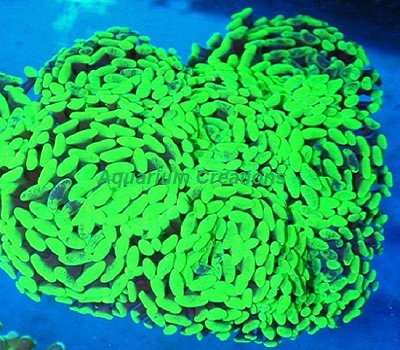The Metallic Green Branching Hammer Coral, (Euphyllia parancora) is a large polyp stony (LPS) hard coral with long, fleshy tentacles with tips shaped like hammers growing from its skeleton that sway in the water back and fourth. They go by the name Hammer Coral or Anchor Coral. It's common names are the result of the similarity in appearance the top of the tentacle polyp look like a hammer. Others think the polyp tops look like a boats anchor. The Hammer Coral polyps are visible throughout both the day and night and when disturbed, hide into its skeletal base. The polyps of the hammer coral may be green, tan, brown, purple, yellow, orange, or gold in color and all colors look great under actinic lighting. This variety is branched like a tree which makes them look similar to a Torch Coral (E. glabrescens).
The Branching Hammer Coral is one of two different skeleton forms Hammer corals are found. Besides Branching Hammer corals, there's the popular Wall Hammer Coral. Each has its distinction. Branching corals, as the name suggests, have individual branches with their own polyps (heads) that grow out of the "mother" branch(es). Branching hammer corals grow both upwards and to the sides. Wall Hammer corals build their skeleton directly on the rock they are attached to. They grow sideways. Most often like a snake waving to the right and the left, often times providing some really interesting shapes to the coral. In comparison to other LPS corals, Hammer Corals grow at a faster pace. The long polyps on both type of Hammer corals will retract at night and come out when the lights kick on. Then the massive tentacles start swaying with the water flow which provides a consistent movement to the reef tank.
Difficulty Moderate
Aggressiveness They have potent sweeper tentacles that it will send out to other corals to keep them from growing too close and will sting anything within reach with its nematocysts. Because of this, you should take care to ensure that your coral has enough room both now and in the future, once the corals in your tank have begun to fill-in the available space.
Water-flow
In terms of water flow, these corals prefer a low-to-moderate flow. Too large a flow will cause the polyps to retract, or be damaged and may also encourage sweeper tentacle issues (see below for more information about that).
Lighting
Since Hammer Corals are found in shallow water regions on the reef it requires moderate lighting levels (from PAR 150-250). T5's, Metal Halides, or LED's can all grow Hammer corals when the proper PAR levels are provided. We recommend a 14-20K color spectrum for best coloration. A warning on using high output lighting; if it will be exposed to brighter lighting it needs to be acclimated to the high output lights in the tank slowly, as it is not usually exposed to intense lighting in the ocean because of its depth. Start out with low lighting, positioning the polyps to face out (versus upwards) and have it shaded by rock or something within the tank. The lighting can gradually get stronger over time, but make the changes very slowly.
Tank Recommendations
A mature, well-fed live rock/reef environment is what is needed, along with some fish for organic matter production, and dissolved organics. As a general rule, caution should be used when mixing leather coral and large polyp stony coral species, including the Hammer coral. Large polyp stony corals protect themselves by wielding their sweeper tentacles maliciously. Many of the leather coral species, protect themselves by releasing toxic chemicals, called terpenes, into the water to stunt the growth of other species to keep the corals away.
Diet and Feeding
It is not necessary to feed a Hammer coral, although they are capable of eating fairly large (by coral standards) meaty foods. The fact that they are biologically able to consume rather large, meaty meals, suggests that feeding should be strongly encouraged. However, Euphyllia parancora could be kept successfully in a reef tank without any feeding at all, as long as adequate lighting is provided, because their symbiotic zooxanthellae will sustain them. If you want it to grow faster I suggest you feed your corals. All of them. Your Hammer coral will feed nicely on frozen mysis, fortified brine shrimp, rotifers, Cyclopeeze and other similarly sized meaty foods.
Problems with keeping the Hammer coral One of the biggest problems I have seen beginner hobbyists have is failing to account for the calcium demand for these corals. If there is insufficient calcium in your aquarium water, these corals will not be able to make their coral skeleton. You should also never lift a Hammer coral out of the water, if you can avoid it. You could tear the polyps, and torn polyps are prone to infection followed by necrosis (a complete deterioration of the tissue).
Reproduction by fragging and budding
The Branching Hammer coral is fairly easy to propagate via fragging. You can cut, saw or snap off a branch and it will grown into an entirely new colony all on its own. A Wall Hammer coral makes a beautiful display but are much more difficult to frag. Cutting the skeleton automatically means the polyps membrane will be cut. Infection can easily occur. We suggest leaving cutting of Wall corals to the pro's.
|



